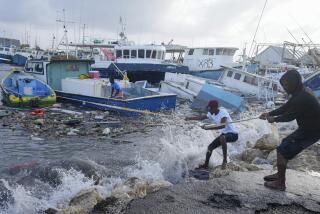Undersea Noise Test Could Risk Making Whales Deaf : Science: Scripps Institution researchers propose the experiment to study global warming. Critics voice alarm.
A plan by scientists to place loudspeakers on the ocean floor off Big Sur and the Hawaiian island of Kauai and blast sounds so loud they could be heard in New Zealand has alarmed some biologists who fear the noise could deafen whales and other marine animals.
The noise, which would be audible to humans and sound something like a bowling ball rolling down a lane, would be broadcast every four hours for 20 minutes until the year 2004 at a volume much louder than sounds known to frighten whales from their normal migratory route.
In a clash between conflicting environmental concerns, the experiment is designed to test whether the temperature of the Pacific Ocean is rising as a result of global warming.
Sponsors of the project at Scripps Institution of Oceanography in San Diego estimate that the noises off the California coast could affect 677,000 marine mammals, but they downplay any serious harm and say the experiment would yield valuable information about ocean temperatures.
Under the plan, one set of loudspeakers would be located about 2,800 feet deep and 25 miles offshore in the Monterey Bay National Marine Sanctuary, where rare blue whales, humpbacks and other whale species gather. A second speaker would be placed at a similar depth off the coast of Kauai near the home of endangered monk seals.
The National Marine Fisheries Service will hold a hearing on the project today in Silver Springs, Md., and decide in coming weeks whether to issue a permit exempting the experiment from regulations that protect marine mammals from human harassment, hunting and killing. The experiment is scheduled to start this spring.
Lindy Weilgart, a Nova Scotia scientist who specializes in studying sperm whale vocalizations, said she fears that the frequent loud noises could cause whales nearby to go deaf, leaving them unable to navigate or find food.
The low rumbling sound would be broadcast at 195 decibels--10 million times as loud as the 120-decibel level known to disturb some whales, she said. The decibel scale is logarithmic. By comparison, humans can suffer ear damage from 120-decibel noises transmitted through the air.
“We are invading an ocean habitat that so far has been untouched by man,” said Weilgart, a post-doctoral fellow at Cornell University. “It’s an experiment of tremendous implications and we are doing it without a clue of what it would do.”
Because whales are difficult to study, little is known about their sensitivity to loud noises or the frequencies at which they hear. But whales appear to be highly acoustic animals, navigating, hunting prey and communicating over long distances by sound. In some cases, loud noises caused by human activity underwater have caused individual whales to lose their hearing and eventually die.
“A deaf whale is a dead whale,” Weilgart said.
In addition to impairing the hearing of some whales, the experiment would cause a constant level of noise pollution in the Pacific Ocean, she said.
Over long distances, the frequent loud sounds could disrupt the normal feeding and mating behaviors of dozens of marine mammal species and disturb fish populations, she said.
“If you hear an irritating hum in the background it can drive you up the wall, even if it doesn’t affect your hearing,” said Weilgart. “It can be a psychological effect.”
For advocates of the project, however, the danger to all marine species from global warming is greater than the harm that loud noises might cause to individual creatures. Global warming is the heating of the planet resulting from human activity, which could cause major climatic changes and alter Earth’s ecology.
They also contend that the broadcasts would be just one of many noises filling the ocean with sound, along with vessel traffic, industrial underwater explosions, supersonic aircraft and earthquakes.
Pioneered by Scripps oceanographer Walter Munk, the planned experiment is based on the newly developed science of acoustic thermometry.
Scientists would measure the time it takes each broadcast to travel across the ocean. Then, because sound travels faster in warmer water, they could plot temperature changes in the ocean over a long period of time.
“This breakthrough method provides temperature measurement over large ocean expanses and can shorten the time scale for characterizing greenhouse trends to a decade, far shorter and more affordable than methods of atmospheric measurement,” says a summary of the experiment submitted to the National Marine Fisheries Service.
The $35-million study would be financed largely by the Defense Department and would rely in part on sophisticated listening gear operated by the Navy.
The initial application for a National Marine Fisheries Service permit proposes a two-year study using the two speaker systems off Point Sur and Kauai. Ultimately, scientists contemplate a network of broadcast points and receivers dotted around the Pacific.
The Scripps researchers estimate that the broadcasts off California could affect as many as 26,000 whales belonging to 10 species, 406,000 dolphins belonging to eight species and 245,000 seals, sea lions and elephant seals.
Ann Terbush, head of the National Marine Fisheries Service’s permit office, said that at the agency’s request, Scripps scientists have given the broadest estimate of the number of marine mammals that would be harassed or killed in the experiment.
“We’re going to need to decide whether this permit should be granted, whether the proposed taking is required and whether it is desirable based on the nature of the research,” she said.
Sounding Off
Some marine biologists are alarmed by a plan to install loudspeakers on the ocean floor off Big Sur that would broadcast sounds at a very high volume in an experiment to gauge global warming. It is feared the noise could harm whales and other mammals in the surrounding marine sanctuary.
Source: National Marine Fisheries Service
More to Read
Start your day right
Sign up for Essential California for news, features and recommendations from the L.A. Times and beyond in your inbox six days a week.
You may occasionally receive promotional content from the Los Angeles Times.






